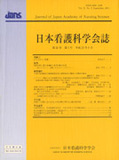Japanese
English
- 販売していません
- Abstract 文献概要
- 参考文献 Reference
- サイト内被引用 Cited by
要旨
本研究は,筋ジストロフィー病棟における看護師と患者との言語的・非言語的交流の様相を通して,看護師と患者に見られる相互作用を明らかにするためにエスノグラフィーを用い,筋ジストロフィー病棟の看護師18名および筋ジストロフィー患者20名,患者の母親3名に参加観察および面接を行った.分析結果から,1.病棟の沈黙の底に潜む看護師の気づかいと患者の歩み寄り,2.言語を介さずに患者の意図を汲む看護師の見えない働き,3.お互いに踏み込むことができない領域の3つのテーマが導き出された.看護師は,自らの感覚を働かせることで患者が感じている身体の感覚を感じ取る「共通感覚」という技を身につけ,言葉を交わすことなく患者の意図を読み取りかかわっていたこと,少ない言葉で通じ合う看護師と患者間の関係が両者に気づかいと甘えを生じさせ,それが死について触れることをお互いに避けようとする関係へと向かわせていることが示唆された.
Abstract
In order to elucidate the interaction between nurses and patients through the verbal and non-verbal aspects of nurse.patient exchanges at a muscular dystrophy ward, employing the method of ethnography, 18 nurses at a muscular dystrophy ward, 20 muscular dystrophy patients, and three mothers of the patients were interviewed and observed in the form of participant observation. Three points are drawn from the results of our analysis:1. Consideration of nurses and concession on the part of patients seen in the silent ward, 2. the nurses' unrecognized service to understand the intentions of patients without using verbal expressions, and 3. a realm that neither group can enter. It is suggested that the nurses acquire an excellent skill in using their sensitiveness to actually understand the physical feeling that the patients experience, which may be called “common feelings.” Using these feelings the nurses take care of the patients by understanding their intentions without relying on verbal communication. It is also suggested that mutual constraint and dependence results from the relationship between the nurses and patients that requires such minimal use of words, which directs the relationship to a point where both of them try to avoid referring to the patient's death.
Copyright © 2011, Japan Academy of Nursing Science. All rights reserved.


